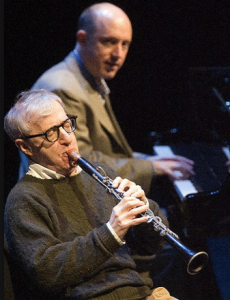By Bob Hicks
One of the signs that a town is turning into a city is that it can’t squeeze everything into a box. So, for instance, while the newest Portland Jazz Festival kicks into high swing (and bop), some terrific jazz is popping up in spots that aren’t connected to the festival at all.
 While the likes of jazz festival headliners Regina Carter, Joshua Redman, Poncho Sanchez, Maceo Parker, Dave Frishberg and the newly Grammy-fied Esperanza Spalding are picking up a whole lot of highly deserved attention in Puddletown, they aren’t the only games in town. You might also have spent Saturday night at an under-the-radar gig with about 75 other people at TaborSpace, in the company of Andy Stein and Conal Fowkes.
While the likes of jazz festival headliners Regina Carter, Joshua Redman, Poncho Sanchez, Maceo Parker, Dave Frishberg and the newly Grammy-fied Esperanza Spalding are picking up a whole lot of highly deserved attention in Puddletown, they aren’t the only games in town. You might also have spent Saturday night at an under-the-radar gig with about 75 other people at TaborSpace, in the company of Andy Stein and Conal Fowkes.
 Who’s that, you ask?
Who’s that, you ask?
Stein is a violinist, a fiddler, an old-time jazz guy with his feet also planted in classical music and rock ‘n’ roll. He’s recorded with Perlman, Domingo, Marilyn Horne and Von Stade; toured with Commander Cody and His Lost Planet Airmen; played with Dylan, Willie Nelson, Emmylou Harris, Tony Bennett, B.B. King and a whole lot more. And he has a special affection for the music of Joe Venuti, the granddaddy of jazz violin.
Fowkes — born in Zambia, raised partly in Mexico, an Englishman now living in New York — is a pianist with equal affections for early New Orleans jazz (he’s a stalwart of Woody Allen and His New Orleans Jazz Band, which is led by banjoist Eddy Davis and features Allen on clarinet) and the traditions of Tin Pan Alley, the great American songwriting system that runs parallel to jazz, routinely jumping the tracks to interlace with it along the way.
Stein and Fowkes, performing as the main act on a bill opened by Portland group Padam Padam, created an evening that did for early jazz a little of what Leon Redbone has done for early 20th century popular music, and Joe Weed for the songs of Stephen Foster, and William Bolcom and Joan Morris for cabaret: it got to the heart of the music and brought it pulsingly into the present. In a low-key patter between tunes the names dropped like a fresh spring rain: Bix Beiderbecke, Coleman Hawkins, Harold Arlen, Louis Armstrong, Hoagy Carmichael, Eddie Lang. At one point, after performing Carmichael’s Georgia on My Mind, Stein and Fowkes went over the original elegant progressions, pointing out how they differed from the Ray Charles version. At another, on exactly which familiar tune chopped into pieces and restlessly rearranged I don’t recall, I got an image of Marcel Duchamp’s modernist painting trailblazer Nude Descending a Staircase, No. 2 — a vision of something totally recognizable yet utterly changed.
That’s a good deal of what this sort of jazz is about: rearranging the familiar. It’s especially at the heart of the jazz connection to Tin Pan Alley, which provided so much of the melodic raw material for an endless progression of abstractions and rearrangements. The songs are grist for the application of virtuosity, and virtuosity is what Stein and Fowkes applied to them — a sophisticated, underplayed, tight yet rollicking showmanship. Sitting straight and balanced at the piano, Fowkes strode the line between rhythm and melody, his forceful left hand anchoring a right hand that whirled with the purposeful energy of a flock of waterfowl startled into flight. It was busy but never over-busy: an arpeggiated ebullience. Stein is a master at breaking things into pieces, sweeping over and under and around the expected, scratching and digging at the surfaces of the songs to reveal them in fresh light. At one point, emulating Venuti, he flipped his bow around, essentially cradling the violin inside it, with the stave belowdecks manipulating the strings above. Their renditions tended to start full-bore and end suddenly and surprisingly, with a practiced that’s-that, like a full-throttle locomotive screeching to a stop without slowing down. Most essential, Fowkes and Stein swung — elegantly, more like Ellington than the blues-driven Basie, but still with guts.
Where does their music fit? Defining its place is a matter of perception and tendency and fine gradations that conversely defy a lot of exactness. Stein’s partiality to Venuti over the other great pioneering jazz violinist, Stephane Grappelli, might (or might not) derive from that little extra American oomph in Venuti’s approach compared to Grappelli’s more European style, with its intimations of Viennese salons. If what you’re looking for in an evening of music is an emotional punch in the gut, these aren’t your boys, although there’s a lot of emotional wisdom in what they play. I found their music more essentially intellectual, although far from cold or dry: like Baroque music, its warmth is one of its greatest appeals. They offered the pleasures of virtuosity — the little turns, the filips, the sly allusions, the shapely curves, the surprises that make you smile, the recognition that they are routinely doing things most people simply can’t do. Plus, they were playing historic music that is all too often ignored, and that is much too good and important for us ever to forget.
*
Top photo: Violinist Andy Stein. Lower photo: Pianist Conal Fowkes, with Woody Allen on clarinet.